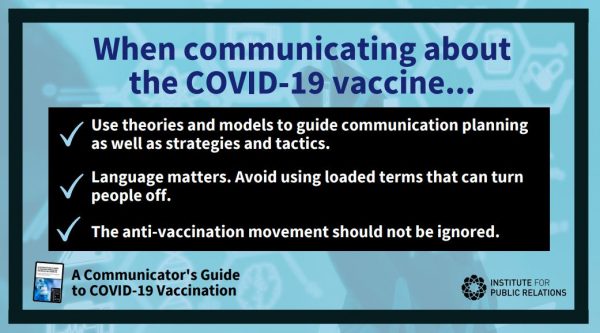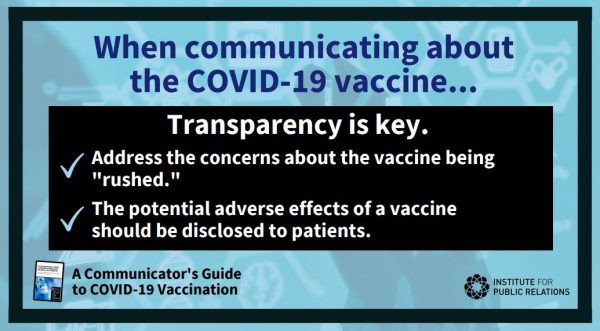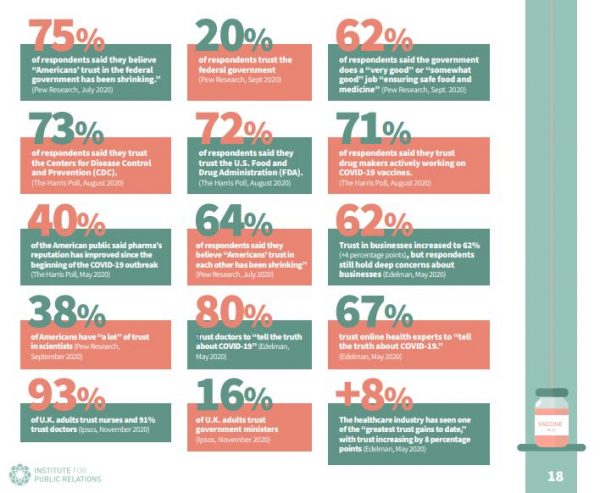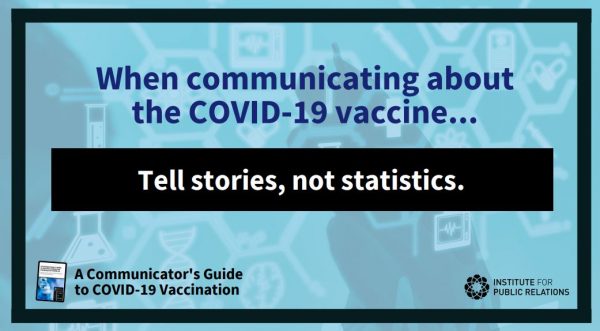Report: How communicators should proceed with COVID-19 vaccine messaging
IPR just published a robust gameplan for comms pros eager to help increase inoculations and dispel skepticism among their fellow workers.
The first major challenge for communicators in 2021 is already here. Not surprisingly, it centers on the global health crisis that upended 2020—and specifically on how communications teams should handle the complex messaging around vaccinations.
To help guide the strategy, the Institute for Public Relations on Monday published “A Communicator’s Guide to COVID-19 Vaccines,” which “outlines research, theories, models, levers, and research-driven recommendations to help ensure effective communication strategies for organizations worldwide.”
Among the questions facing internal-comms pros:
- How will your company communicate about COVID-19 vaccinations?
- Will you take a stand on this issue?
- Will those who refuse to get the vaccine be allowed to enter the office?
- Can you legally force workers to get inoculated?
- How do you plan to respond to employee objections—or to those who are vocal and skeptical about the efficacy of vaccinations?
IPR’s report packs a punch of data-backed guidance for communicators who are keen to play a key role in stemming the rising tide of this miserable pandemic. Employees are increasingly looking to their employers as reliable sources of information. This raises a critical opportunity for comms teams to help subdue the health crisis.
“Understanding what people know, how they think, their behavioral intentions, and subsequent behavior can help increase vaccine uptake,” says Tina McCorkindale, IPR president and CEO. The report “offers a pathway for communicators to reduce uncertainty about the vaccine.”

(Image via IPR)
IPR’s report shares 17 key findings to help communicators shape their COVID-19 vaccination game plan. The takeaways and tactics include:
Vaccine hesitancy is not due to a lack of information. It’s more about fear of the unknown. Which, considering how quickly the vaccine was created, is understandable. So, instead of hammering employees with “Do it, now!” messaging, IPR says to treat those who are on the fence with “compassion, sensitivity and respect” as you let science and data build your case for employees to get the shot.
Transparency is key. If you intentionally hide something, it will eventually come to light. That’s true with all communication, but if messaging about such a sensitive topic is anything less than transparent, you run the risk of profoundly damaging employee trust. Be honest about any vaccine side effects, and don’t bury crucial information underneath a bed of jargon.

(Image via IPR)
Tailoring communication with each audience is essential. “Attitudes and perspectives on vaccinations can vary widely depending on demographics, at-risk factors, religion, psychographics, culture, political views, news consumption, geographic locations, technographic factors, among others,” the report states.
To achieve better comms results, you’ll need to do the legwork of segmenting your target audiences and recasting information accordingly.
Use theories and models to guide communication planning as well as strategies and tactics. IPR recommends delving into behavioral science and the underlying causes of cognitive motivation to craft more persuasive messaging. Start by considering the elements of the Behavior Change Wheel.
Marginalized groups have lower vaccine confidence. People of color have been disproportionately affected by COVID-19. The pandemic has understandably sparked mistrust in minority and low-income communities, who continue to suffer the consequences of historic and current inequities. Communicators should prioritize messaging that pertains specifically to employees of color—preferably with input from people within those communities.
Trust doctors and nurses. Don’t share information from sketchy websites or sources that might be deemed controversial. Instead, lean on guidance and advice from trusted doctors, nurses and health experts.

(Image via IPR)
Opinion leaders should be identified for target audiences. You might not get three former presidents to receive the shot for a video on your intranet, but you should seek cooperation from those who wield considerable internal clout.
“Vaccinate credible influencers within defined communities to demonstrate vaccine confidence,” the report states. “Per social-contagion theory, people have a tendency to think and act like their friends and family, which encourages adoption of behaviors.”
The anti-vaccination movement should not be ignored. Instead of ignoring misinformation, actively counter it with reputable science. IPR notes that you’re unlikely to change any anti-vaxxers’ minds, but you must provide a counter-balance for those who are on the fence and could be persuaded to get inoculated.
As Brendan Nyhan writes in The Atlantic, the anti-vax crowd is actually quite small, despite their outsize voice online. It doesn’t hurt to try to convince them, but your efforts should be centered on those who are undecided. He writes:
“The most important group, however, is made up of Americans with mixed-to-somewhat-favorable attitudes toward vaccines. Though the childhood-immunization data suggest that parents in this group vaccinate their children at very high rates, they are less likely to get vaccines themselves as adults (for instance, by getting a flu shot every year). Persuading them to get a COVID-19 vaccine will be crucial—this group is both much larger as a proportion of the population than the anti-vaccine fringe and also more receptive to public-health guidance.”
Tell stories, not statistics. Emotional storytelling defeats cold data every time in the game of persuasion.
Instead of making employees’ eyes glaze over with rafts of stats, tell first-person accounts of COVID-19’s impact on specific people. Crystallize the very personal toll this pandemic is taking on the workforce, and emphasize the need to protect one another.

(Image via IPR)
Agencies must be aligned. Make sure your messaging dovetails with what local hospitals and health leaders are communicating. Trust will quickly dissipate if employees are hearing scattershot, conflicting messages on how to proceed.
Misinformation should not be repeated. Don’t amplify fake news. Instead, present clear, cogent rebuttals to rumors or false claims—backed with sources to credible institutions.
Inoculate people against misinformation. In the same vein, it’s wise to anticipate common vaccine objections and questions. Counter these doubts with robust data—or perhaps engaging, animated videos.
Understand biases. Communicators should account for employees’ omission bias, which “indicates a strong preference for inaction even when taking action is more beneficial,” and confirmation bias, which is seeking info that only confirms pre-held beliefs. Your messages should actively counter those powerful cognitive forces.
Help encourage health literacy. IPR’s report states that “low health literacy is more prevalent among older adults, minority populations, those with low socioeconomic status, and medically underserved people. Offer programs and workshops to help employees become more health literate.”
Proactive information campaigns carry the added benefit of debunking false claims, too.
Language matters. Be precise in your writing, and err on the side of clarity. Err on the side of compassion, too. Using terms such as “anti-vaxxer” or “insane conspiracy theorists” won’t win any friends to your cause.
Listen. Don’t ignore workers’ concerns or chatter on this issue. Listen to what employees are saying, and craft content based on which concerns or questions they’re voicing. Send out pulse surveys on these topics to make sure you’re getting plenty of feedback and opinions before you act.
Technology can help increase uptake. “Digital push technologies, such as text messaging, have been effective at increasing uptake (including for a series vaccination like the COVID-19 vaccine) for some audiences,” the report states. “Gamification is also effective for changing attitudes and behavior, such as identifying and dismissing disinformation.”
Over to you, communicators. How are you handling COVID-19 vaccine announcements? Have you started planning your vaccination messaging? Please share your guidance below.







